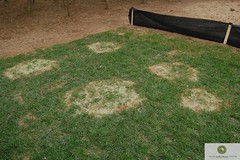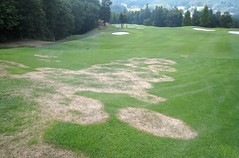
The major news around here this week has been the weather. No, that's not a photo of the Mother Ship come to take me home, that's the back of one of the many storm fronts that passed through this past week.
I'm sure you have all heard about the devastating tornado in Joplin. Other communities in the region were also struck.
Along with the violent winds, hail, etc, abundant rain has accompanied some of the storms. The University of Arkansas talks about wet conditions in their area. They also shared some images of flooding from some storms a few weeks back.
http://turf.uark.edu/turfhelp/archives/052511%20Rain.html
Here are some examples of how dark the sky got on Monday here in Manhattan. The clouds were so dark (at 10:00 am) that streetlights and car headlights were coming on:


Large patch
I was out and about earlier this week and saw some large patch symptoms:


At this site, the symptoms were a lot less common than they were in 2010. 2010 was extremely wet, and I think that's a big factor. After this week's cool, rainy weather, I expect to see a rise in symptoms.
Wet conditions also prohibited mowing, leaving a purple haze of several days of zoysia flowering heads:
In the dicot world: (oops, I mean non-turf world)
Those of you who deal with ornamental plantings might be interested in these observations about freeze damage in peonies and iris from a cold snap a couple of weeks ago. The pics and commentary are from one of my colleagues in the Kansas City area:
http://www.ksuturf.org/blog/2011/05/freeze-damage-in-iris-and-peony/



































